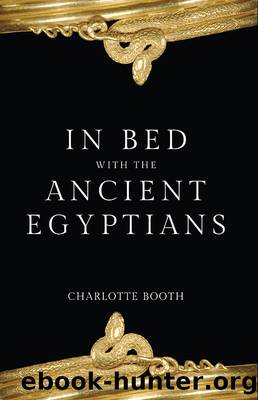In Bed with the Ancient Egyptians by Charlotte Booth

Author:Charlotte Booth
Language: eng
Format: epub
Publisher: Amberley Publishing
Published: 2015-10-28T16:00:00+00:00
5
HOMOSEXUALITY
‘How beautiful are your buttocks, how vital!’1
In previous chapters, we have investigated heterosexual relationships, essentially those that ended in marriage and children. However, the homosexual lives of the ancient Egyptians is a little more complex, as there are even fewer records because such relationships never ended in marriage or some other documented agreement. So the question is, did homosexuality occur in ancient Egypt? The simple answer is yes, but a more important question is how was homosexuality expressed in ancient Egypt?
Trying to identify and subsequently discuss homosexuality in ancient Egypt is a difficult task, and not just because the evidence is lacking, but also because the concept of homosexuality, as we understand it, did not exist in the ancient past. Terms such as ‘gay’, ‘lesbian’ or even ‘homosexual’ are modern terms associated with modern contextual constructs and cannot be applied to the ancient past, and indeed none of these words existed in ancient Egypt. Furthermore, there was no word for sexuality, as the concept did not exist in the same way. To give an idea of the modernity of the terms, the word ‘homosexual’ was only introduced in the 1860s CE.2 As such modern terminology generally used describes modern constructs, ancient sexuality is often misread, as we can only interpret it within the boundaries of these constructs.3 Moving away from these terms, and their associated meanings, is however extremely difficult. So, how do we discuss such relationships in the past? Meskell suggests that the only appropriate term to use is ‘same-sex relations’,4 but even this neutral term is not one that was used by the ancient Egyptians themselves.
In the modern world, the terminology we use describes the person, for example, ‘N is gay’, whereas in ancient Egyptian the sexual act was referred to more than the person. Homosexual relationships were categorised according to who was penetrating and who was penetrated. The former had no specific label or title, whereas the latter was known as nkkw, he who is penetrated, or Hmiw, back-turners or cowards, which is related to the word Hmt, wife, indicating this passive element of homosexuality.5 In the Old Kingdom, there was a broader element of abuse and aggression attached to the term nkkw, which changed in the New Kingdom to simply refer to passivity of the act of being penetrated.6 A rather controversial term, Hmt-T3y is used in the Instruction of Ptahhotep, and there has been much debate about the translation as it combines male and female sexuality. It has been translated as woman boy,7 vulva boy,8 the wife and a man9 or, more commonly, a woman who has intercourse with a man (see chapter 2). The section in the text is discussing the effects of greed, which naturally are negative:
It embroils fathers and mothers, with mother’s brothers.
It entangles the wife and the man (Hmt T3y).
It is a levy of all evils, a bundle of all hatefulness.10
Some have even suggested that this term refers to a male prostitute who is acting as a means of expelling such homosexual/abnormal feelings.
Download
This site does not store any files on its server. We only index and link to content provided by other sites. Please contact the content providers to delete copyright contents if any and email us, we'll remove relevant links or contents immediately.
Cecilia; Or, Memoirs of an Heiress — Volume 1 by Fanny Burney(31326)
Cecilia; Or, Memoirs of an Heiress — Volume 3 by Fanny Burney(30929)
Cecilia; Or, Memoirs of an Heiress — Volume 2 by Fanny Burney(30886)
The Great Music City by Andrea Baker(21196)
We're Going to Need More Wine by Gabrielle Union(18067)
Bombshells: Glamour Girls of a Lifetime by Sullivan Steve(13102)
Pimp by Iceberg Slim(12924)
All the Missing Girls by Megan Miranda(12741)
Fifty Shades Freed by E L James(12444)
Norse Mythology by Gaiman Neil(11876)
Talking to Strangers by Malcolm Gladwell(11865)
Crazy Rich Asians by Kevin Kwan(8343)
Mindhunter: Inside the FBI's Elite Serial Crime Unit by John E. Douglas & Mark Olshaker(7830)
The Lost Art of Listening by Michael P. Nichols(6465)
Enlightenment Now: The Case for Reason, Science, Humanism, and Progress by Steven Pinker(6404)
Bad Blood by John Carreyrou(5763)
The Four Agreements by Don Miguel Ruiz(5503)
Weapons of Math Destruction by Cathy O'Neil(5032)
We Need to Talk by Celeste Headlee(4863)
